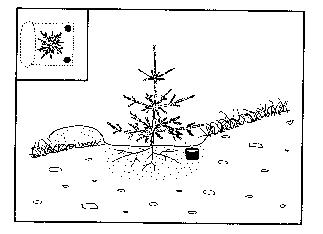Growth and development of spruce and pine plantations fertilized by tablets
Vaclav Narovec

Usage of fertilizing tablets is one of the methods used for the individual fertilization of tree species plants in the plantations. The fertilizing tablets with complex content of the basic nutrients including microelements are placed on the planting hole bottom or into the planting hole wall at outplanting. The fertilizing tablets work also for additional fertilizing the plantations already outplanted. At this case the tablets are managed near to tree roots. The references related to theme mentioned above we can find out e.g. at AUSTIN & STRAND 1960, BERRY 1979, DONOV & JORDANOV 1977, FIEDLER & RUETZ 1983, KOBERG 1974, OSAKO 1981, ROTHACHER & FRANKLIN 1964, WILDE & WITTENKAMP 1942, et al. Experiences obtained from the fertilizing with tablets of forest tree species plants are not satisfactory (BENGSTON 1979, CERVENKA 1988, HAUSSER 1976, LOKVENC 1981, 1987; MATERNA & LEDINSKY 1987, MULLIN 1981, SOJAK & OBR 1989, WOESSNER 1977).
In spring 1987 the Prerov Chemical Plants (Precheza, a.s.) began to supply the new fertilizing tablets with commercial name Preform. It is a complex fertilizer free of chloride shaped like tablet of diameter 30 mm, thickness 18 mm, weight 24 g and with basic nutrient content as follows: 11% N; 10% P2O5; 11.5% K2O; 2% MgO; 0.3% microelements. Related to prompt practical spread of tablet fertilizer Preform usage for additional fertilizing the tree species plants in plantations one had to gain knowledge about growth and performance of plantations fertilized by tablets.

The fertilizing tablet Preform efficiency on growth and performance of forest tree species plants was examined in three experimental plots planted with Norway spruce (Picea abies [L.] Karst.) and in three experimental plots planted with Scotch pine (Pinus sylvestris L.). One used the following criteria for evaluation of fertilizing tablet impacts on growth and performance of spruce and pine plantations: total mean height and height increment of plants in samplings on experimental subplots (in particular years after additional fertilizing), stem diameter measured 1 cm above soil surface and diameter increment and rates of declining plants. The index D2H (seedling volume index, where D - stem diameter 1 cm above ground, H - total plant height) and the index PVI (plot volume index - D2H of all plants on an experimental subplot) by MARX & ARTMAN (1979) were calculated from the primary data.
The efficiency of fertilizing tablets Preform on growth and performance of containerized spruce seedlings growing in Jiffy pots of volume 0.7 l were also examined. Tracing the dynamics of nutrient leaching from tablets and watching on mechanical property changes of fertilizers during storage completed our investigations.
From the results of studying the efficiency of fertilizing tablets Preform on growth and performance of spruce and pine plants we can conclude that using the tabletted fertilizers does not increase survival of plants after outplanting. The differences in survival during the first three years after outplanting between the plants fertilized are with tablets and the plants not fertilized are negligible (when the right fertilizer application excludes the close contact of fertilizer with roots).
As regards the height increment of Norway spruce and Scotch pine, the application of tablet fertilizer Preform did not induce the significant increase of the plant terminal shoot increment in the year with applying the fertilizer. The additional fertilization of the plantations by tablets promoted the height growth of plants only in the second growing season after additional fertilizing. The positive effect of additional fertilizing on the height increment of plantations was found in some cases also in the next year. Then that effect usually ceased. In optimum case the additional fertilization of plantations by tablets Preform may induce the partial promotion of plant height increment in the first three to four years after outplanting: the forest tree species with minor initial growth rate (spruce in mountain conditions) show the increase of height increment by about 10 cm in total, the forest tree species with greater initial growth rate (pine) show the increase of height increment by about 20 cm in total.
In case of application of fertilizing tablets Preform with dose two to four pieces for a single plant into already established (older) plantations (three to four years after outplanting) one did not find any effect on the increase of growth height of examined plantations. The diameter increment of plantations was affected (increased) by additional fertilization with tablets Preform only negligibly. The investigation of nutrient leaching rate from the fertilizing tablets Preform I (lysimetric experiment) proved very intensive leaching nitrogen and potassium from the fertilizing tablets during the first mount after application of fertilizer into the soil. The storage experiment also pointed at unsteadiness of mechanical properties of the fertilizer during the storage.
From the investigation of functional tablet fertilizer Preform efficiency on growth and performance of plantations we can conclude: application of fertilizing tablets into the planting hole at establishing the plantations in immission regions may represent one of the possible alternatives of profylactic fertilizing the plantations in the fertilizing system of forest plantations. At fertilizing the older plantations one must regard to the special state and to the nutrition conditions of forest tree species on the special site. In such case the nutrition treatments must be proposed on the basis of detailed ameliorative recognition.
Last update: September 22, 2002.